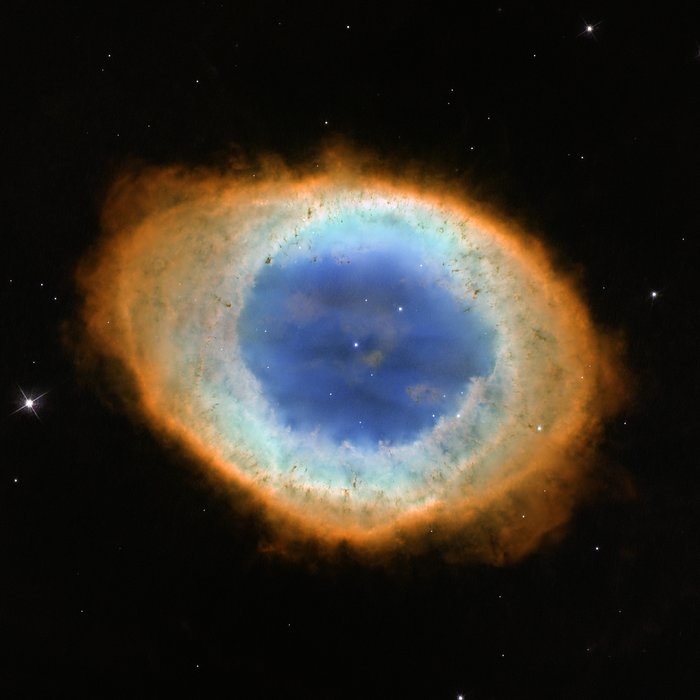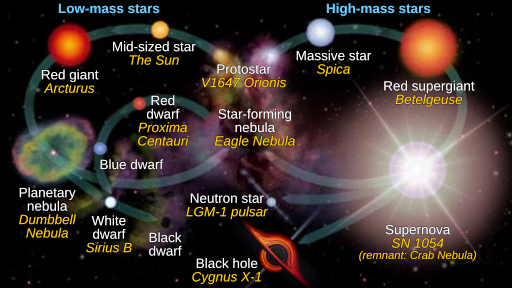OCR Specification focus:
‘Explain Sun-like evolution into red giant, planetary nebula, and white dwarf stages.’
Low-mass stars such as the Sun evolve through well-defined stages governed by changing internal pressures, nuclear fusion processes, and structural transformations that determine their eventual fate as white dwarfs.
Low-Mass Stellar Evolution
Low-mass stellar evolution refers to the life cycle of stars with an initial mass up to about eight times that of the Sun. These stars follow a predictable evolutionary pathway because their internal temperature and pressure never become great enough to fuse elements significantly heavier than helium. Their journey from hydrogen-burning stars to compact remnants provides key insights into stellar cores, nuclear fusion, and pressure support mechanisms in astrophysics.
The Main Sequence Phase
Low-mass stars begin their stable lives on the main sequence, where they fuse hydrogen into helium within their cores. This fusion process provides outward radiation pressure, balancing the inward force of gravity. During this long-lasting stage, the star remains in hydrostatic equilibrium and maintains a steady luminosity and temperature. As hydrogen in the core is gradually depleted, the equilibrium becomes increasingly difficult to sustain, initiating the next evolutionary step.
Core Contraction and Shell Hydrogen Fusion
When the hydrogen supply in the core becomes insufficient, fusion ceases in the core region. Without energy input to oppose gravity, the core contracts and heats up. Surrounding this contracting core, a shell of hydrogen reaches the necessary conditions for fusion. Hydrogen shell burning is more luminous than the former core fusion stage and leads to the expansion of the outer stellar layers.
This expansion lowers the surface temperature, causing the star to shift towards the cooler, brighter region of the Hertzsprung–Russell diagram. The star now begins to develop the distinctive structure that will transform it into a red giant.
The Red Giant Phase
A red giant is a swollen, luminous star formed when the outer layers expand enormously due to increased energy output from hydrogen shell burning. The radius of the star can grow hundreds of times larger than its original main sequence size, even though its surface temperature decreases.
Red Giant: A luminous, greatly expanded phase of low-mass stellar evolution caused by hydrogen shell fusion around an inert helium core.
Within the interior, the contracting helium core becomes extremely dense and hot. Eventually, the core temperature reaches around 100 million kelvin, the threshold necessary for the next major fusion process.
The Helium Flash and Helium Fusion
Once the core temperature is high enough, helium nuclei begin to fuse into carbon via the triple-alpha process. In stars like the Sun, this ignition occurs explosively in a brief but intense event known as the helium flash. Despite the dramatic internal change, the star’s outer appearance alters only moderately. After the helium flash, the star settles into another period of equilibrium, fusing helium in the core and hydrogen in the surrounding shell.
A short sentence here helps transition before the next section, ensuring clarity of structure.

Schematic of the triple-alpha reaction: two helium-4 nuclei form unstable beryllium-8, which captures another helium-4 to produce carbon-12 and release energy. Source.
Formation of the Planetary Nebula
After helium in the core is exhausted, fusion ceases once again in the central region. Gravity causes further contraction of the core, but not enough heat is generated to fuse heavier elements. The outer layers become unstable and begin to drift away from the core. A combination of pulsations and strong stellar winds ejects the star’s outer envelope into space.
Planetary Nebula: An expanding shell of ionised gas ejected from a low-mass star near the end of its evolution, illuminated by the hot core.
The exposed, increasingly hot core emits ultraviolet radiation that ionises the expelled gas, producing the glowing structure known as a planetary nebula. Despite the name, planetary nebulae have no connection to planets; the term arose from their early telescopic appearance.

Hubble image of the Ring Nebula (M57), a classic planetary nebula created by a Sun-like star shedding its outer layers and revealing a hot core on the way to becoming a white dwarf. Source.
The White Dwarf Remnant
The remnant core left behind after the planetary nebula stage is a white dwarf, a dense stellar object typically composed of carbon and oxygen. It no longer undergoes nuclear fusion and instead shines due to residual thermal energy.
White Dwarf: A dense stellar remnant supported by electron degeneracy pressure after the outer layers have been shed as a planetary nebula.
White dwarfs are supported by electron degeneracy pressure, a quantum mechanical effect arising from the Pauli exclusion principle. This pressure does not depend on temperature, allowing the white dwarf to remain stable even as it gradually cools over billions of years. Their mass is typically comparable to that of the Sun, while their radius is similar to that of Earth, demonstrating extraordinary density.
A further short statement here helps maintain narrative continuity before presenting structured information.

Stellar life-cycle diagram emphasising the low-mass star pathway from main sequence through red giant, planetary nebula and white dwarf; the high-mass track on the right is outside this sub-topic’s scope. Source.
Key Stages of Low-Mass Stellar Evolution
Main sequence: Hydrogen fusion in the core maintains stability.
Hydrogen shell burning: Core contraction ignites a hydrogen shell.
Red giant phase: Outer layers expand dramatically.
Helium flash: Sudden onset of helium fusion.
Helium-burning phase: Core helium fuses into carbon.
Planetary nebula ejection: Outer layers disperse into space.
White dwarf formation: Dense, cooling remnant remains.
Importance in Astrophysics
Studying the evolution of low-mass stars gives insight into stellar populations, chemical enrichment of the interstellar medium, and the long-term future of stars like the Sun. Their predictable path from main sequence to white dwarf makes them essential benchmarks in understanding how energy generation, pressure balance, and nuclear processes govern stellar behaviour across the universe.
FAQ
A star follows the low-mass route if its initial mass is roughly eight solar masses or below. These stars never achieve the extreme core temperatures required to fuse elements significantly heavier than helium.
Their internal pressure is dominated by thermal processes and later by electron degeneracy rather than the extreme gravitational compression seen in massive stars.
In low-mass stars, the helium core becomes electron-degenerate before it heats enough for helium fusion. Degenerate matter cannot expand when heated, so the onset of helium fusion becomes explosive.
In high-mass stars, the core is hot enough to avoid degeneracy before helium ignition, allowing a smoother, non-explosive transition into helium fusion.
As the red giant phase progresses, the star develops instability in its outer layers. These layers begin to pulsate due to alternating cycles of compression and expansion.
Pulsations help lift material away from the star by reducing gravitational binding and enabling strong stellar winds to expel gas into space, creating the early structure of a planetary nebula.
A white dwarf has no ongoing nuclear fusion, so it cannot generate new energy. It radiates its stored thermal energy into space.
Over billions of years, it cools steadily as its internal heat reservoir diminishes.
This cooling follows a predictable pattern, making white dwarfs useful cosmic chronometers for estimating the ages of stellar populations.
The expelled gas disperses into the interstellar medium, enriching it with heavier elements such as carbon and nitrogen created during the red giant phase.
This recycled material can later contribute to:
New star formation
Planetary system development
Nebular structures that seed molecular clouds
The planetary nebula stage is therefore a crucial mechanism for redistributing processed material back into the galaxy.
Practice Questions
Question 1 (2 marks)
Explain why a low-mass star expands into a red giant after the hydrogen in its core is exhausted.
Mark Scheme:
Core hydrogen fusion stops, causing the core to contract under gravity and heat up. (1 mark)
Hydrogen fusion occurs in a surrounding shell, increasing energy output and causing the outer layers to expand into a red giant. (1 mark)
Question 2 (5 marks)
Describe the sequence of evolutionary stages a Sun-like star undergoes after leaving the main sequence. In your answer, refer to the processes occurring in the core and outer layers of the star, and explain how these lead to the formation of the final stellar remnant.
Mark Scheme:
Award up to 5 marks for the following valid points:
Core exhausts hydrogen, leading to contraction and heating. (1 mark)
Hydrogen shell burning begins around the inert helium core. (1 mark)
Increased luminosity causes the outer layers to expand, forming a red giant. (1 mark)
Helium ignites in the core via the helium flash, followed by helium fusion into carbon. (1 mark)
Outer layers are expelled as a planetary nebula, leaving a white dwarf supported by electron degeneracy pressure. (1 mark)

